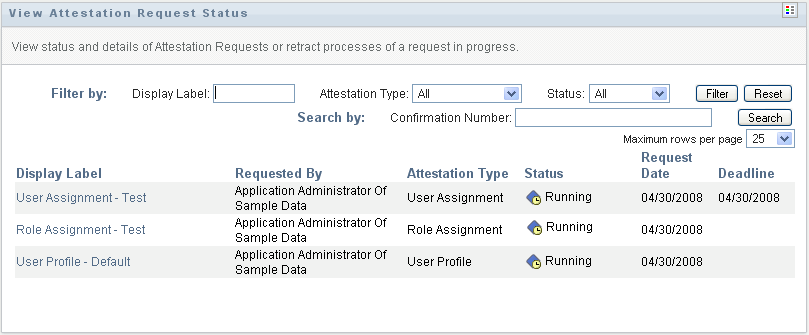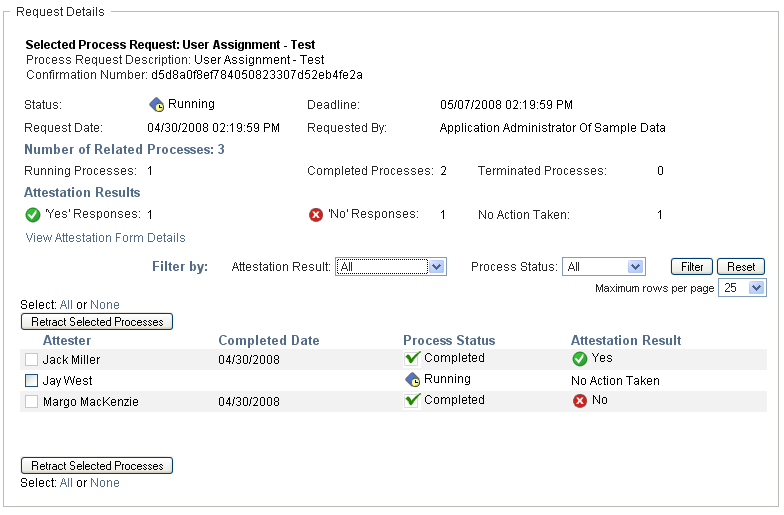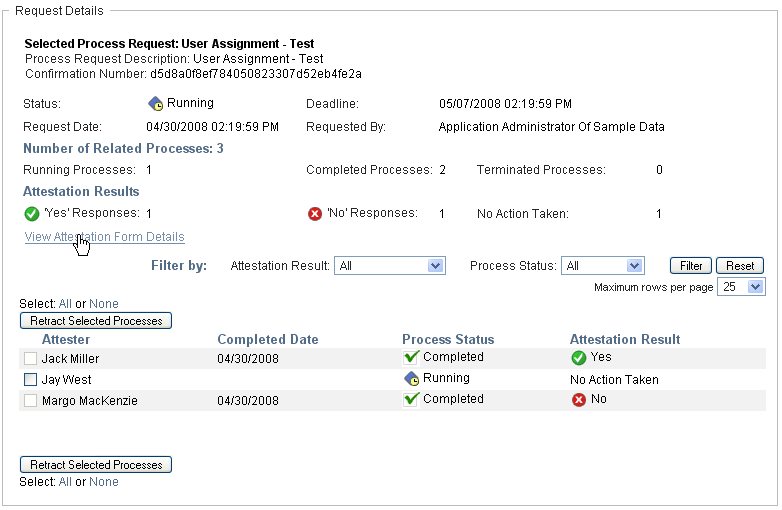20.6 Checking the Status of Your Attestation Requests
The action lets you see the status of your attestation requests. In addition, it gives you the option to see the detailed status for each workflow process started for a request and optionally retract one or more running processes.
The action shows all attestation requests, including those that are initializing, running, completed, or in error.
The User Application does not place any restrictions on what the Compliance Module Administrator and Attestation Manager can see on the View Attestation Request Status page. Both of these roles permit access to status information about all attestation requests.
To look at your attestation requests:
-
Click in the list of actions.
The User Application displays the current status of all attestation requests.

The columns in the attestation request list are described below:
-
The column provides the name of the attestation process specified for the request. You can see the detailed status information for the request by clicking on the process display name.
-
The column identifies the user who made the request.
-
The column indicates what the type of attestation process this is. The type determines what kinds of information the process is intended to certify, as follows:
-
The column shows the status for the request as well as an icon that provides a visual indicator for the status. You can select the status from the dropdown and click to narrow the results when searching for requests with a particular status:
-
The column shows the date when the request was made.
-
The column shows the date by which all of the processes associated with this request must be completed. If the column is blank, the request has no deadline.
-
-
You can filter the list of requests, as follows:
-
To view only those requests that start with a particular string of characters, see Filtering Data for information about what to type in the box.
-
To view only those requests that have a particular type, select the type in the dropdown.
-
To view those role requests that have a particular status, select the status in the drop-down list.
-
To apply the filter criteria you’ve specified to the display, click .
-
To clear the currently specified filter criteria, click .
-
-
To search by the confirmation number that was generated when the request was first submitted, type the number in the field, and click .
-
To set the maximum number of requests displayed on each page, select a number in the drop-down list.
-
To sort the list of requests, click on the column heading that contains the data you want to sort.
-
To see the details for a particular request, click on the name in the column and scroll down until you see the group box.
NOTE:If the status is Initializing, the is not clickable, because you are not able to view the details of an initializing request.

In addition to showing information already displayed in the summary, the group box shows status information for all processes related to the request.
-
The section gives the total number of processes, as well as the number of running, completed, and terminated processes.
-
The section provides data on how the attesters responded:
-
To view details for a particular attestation form, click .

The form details for an attestation process show the kind of information the attesters are expected to review. The form details vary depending on whether the attestation type is User Profile, SoD Violations, or Role Assignment.
To hide the form details, click at the top of the form details group box.

For information on the form details that attesters must review when they claim a workflow task, see Section 10.2.3, Claiming a Task.
-
You can filter the list of processes, as follows:
-
To view only those processes that have a particular result, select the result in the dropdown.
-
To view those processes that have a particular status, select the status in the drop-down list.
-
To apply the filter criteria you’ve specified to the display, click .
-
To clear the currently specified filter criteria, click .
-
-
To set the maximum number of processes displayed on each page, select a number in the drop-down list.
-
To check the status for a particular attester, look at the column for the attester.
The field shows the status for the process, along with the status icon. The icon provides a convenient way to see the status at a glance. The table below describes the status codes:
-
To retract one or more processes, select the attesters and click . If you want to retract all processes, click . To clear your selection, click .
The checkbox is disabled if the process has been completed or terminated. The button does not appear if the high-level request status is Completed or Error.
-